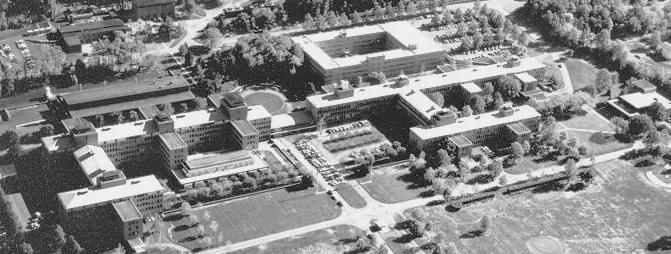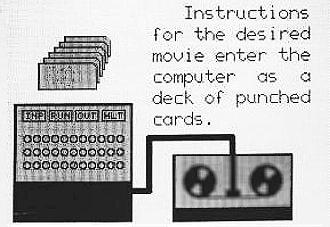PORTRAIT OF THE ARTIST AS A YOUNG SCIENTIST (YLEM Journal, Jan/Feb 2005 25 No. 2)
|
If you don't know where you're going,
you will surely end up somewhere else. To be sure of hitting the target, shoot first, and call
whatever you hit the target. Basic research is what I'm doing when I don't know what
I am doing. One never goes so far as when one doesn't know where
one is going. |
| Through today's lens — near-future and pragmatic — it was
a place of misty legend: that brick and mortar fortress on a hill in the
Northeast Kingdom of New Jersey. Quiet and apparently innocuous. But stealthy,
to those who read its press releases as warnings of upheaval down the
road. To most folks, its announcements — about atoms, plasmas, phonons,
and such figments of science — were of little relevance to their composures
or bottom lines.
Bell Telephone Laboratories, as my colleagues and I experienced it during the 1960s and 1970s, was a beehive of scientific and technological scurrying. Practitioners within, tethered on long leashes if at all, were earnestly seeking enigmatic solutions to arcane puzzles. What happened there would have baffled millions of telephone subscribers who, knowingly or not, agreeably or not, supported the quiet circus.
For people who believe in science, and who still believe in technology, it was the epitome of free exploration into how the world did, or could, work. For those concerned with tangible results, the verdict, albeit delayed, is indisputable: fiber optics, the transistor, Echo and Telstar, radio astronomy including confirmation of the Big Bang. Advances in metallurgy, computational methods, and all manner of information storage, transmission and processing. Bell Labs truly was a national resource, and for anyone who was there or who cared, its decline is one of the great tragedies of the past half century. You may be familiar with the names of people I knew there: Claude Shannon, John Pierce, William Baker, and a dozen Nobel laureates, McCarthur Fellowship "geniuses" and other notables. Like Richard Hamming who, soon after I arrived from MIT in 1962, advised me to "slow down — if everyone here made more than one contribution to the Bell System in his lifetime, the System would be in chaos." At first startled, I did accepted this as an excuse not to obsess over telephones. My main interest was computers, particularly their use in picture-making. The Labs had a new microfilm printer that exposed letters and vectors on 35 mm film. Some of my friends — Mike Noll, Ed Zajac and Frank Sinden — were soon making simple movies (with terrible vertical jitter because the camera lacked filmgate registration pins).
My own shtick became a sort of greyscale picture made by filling the screen with thousands of different letters chosen for their brightness. I soon wrote a memo to department head Tom Crowley, suggesting the possibility of a "computer language" for making animated movies; his two-part response launched my career in raster graphics: "It sounds rather ambitious, but why don't you see what you can do?" Within a year, I had a set of subroutines someone dubbed BEFLIX, acronym for "Bell Flicks," arguably the first computer language specifically for bitmap movie making. (I have also been called the inventor of the pixel, which is a bit of a reach, though I might claim independent discovery.) I used BEFLIX, of course, to make a movie about the process by which it was made. It had no sound track, was unbearably dreary and highly schematic. But this, in 1964, was a first of sorts, and Bell Labs arranged a press conference for fellow movie makers and me to crow about our accomplishments.
I remember in particular one reporter who badgered me about the possibility of someday resurrecting Rock Hudson and Doris Day, by computer, to star in posthumous movies. I argued that nothing like that would ever happen: it was too complicated, and certainly not worth the effort; computers were for serious scientific movies, for example about atoms, whose cavorting could be scripted by vectors and equations. Unswayed, his newspaper story about computer animation featured Rock Hudson and Doris Day. (As we all now know, the obstreperous reporter's imagination was right on target.) The BEFLIX language did serve, non-reflexively, a couple years later for a set of films that I made about my list-processing language L-6 (the Laboratories' Low-Level Linked List Language); it contained an early case of articulated animation in which insect-like base pointers crawled about in the computer, pointing to blocks of memory.
The nonscientific, some say artistic, aspects of computer graphics arose for me via a sophomoric prank. Ed David, two levels up, was away for while and the mice, one might say, played ever more freely. Leon Harmon stopped by to ask me for help with a brilliant idea: when Ed returns, one entire wall of his office will be covered with a huge picture made of small electronic symbols for transistors, resistors and such. But overall, they will form a somewhat-hard-to-see picture of, guess what, a nude! And so the renowned Harmon-Knowlton nude was conceived, coaxed into being, and duly hung on Ed's wall. Ed was delighted but worried. More viewers than we had expected were apparently familiar with the subject matter, and could "see" the 12-foot-wide picture from as many feet away. It was therefore judged an unseemly decoration for the Labs, especially midway up the hierarchy. After just one day of glory there, she was retired to Ed's basement rec-room. Smaller versions of the big picture mysteriously did propagate (we had not the slightest idea how); the PR department scowled and warned that "you may circulate this thing, but be sure that you do NOT associate the name of Bell Labs with it." But the big version burst forth a while later at a press conference on Art and Technology in Robert Rauschenberg's loft, and on the watershed date of October 11, 1967, it appeared atop the first page of the second section of the New York Times, which made not the slightest effort to conceal its birthplace. Billy Kluver claims that this was the first time ever that the Times printed a nude! The PR department huddled and decided, so it seems, that since she had appeared in the venerable Times, our nude was not frivolous in-your-face pornography after all, but in-your-face Art. Their revised statement was: You may indeed distribute and display it, but be sure that you let people know that it was produced at Bell Telephone Laboratories, Inc.
We did make similar pictures — of a gargoyle, of seagulls, of people sitting at computers — which have appeared here and there. But it was our Nude who would dolphin again and again into public view in dozens of books and magazines. Sometimes it is excused by a more dignified title, like Studies in Perception I; once the two of us were photographed in front of it, providing a scant two-piece cloak of modesty. Just recently I encountered it in Lewis Mumford's The Myth of the Machine (1970) where, as last in a three-panel display, it demonstrates progress (or regress) in mechanization of the portrayal of woman. That was the beginning for me of a fascination with large pictures made of small things that has occupied my eyes, hands and mind ever since. It was also my first conscious buffeting by chaos: a mischievous butterfly had flapped, and a huge chunk of my career and persona veered onto a new course. On the other hand, and again by chance, my debut as artist was postponed for several years. How so? Because Art-and-Technology was the rage, and The Museum of Modern Art had a "Machine Show," and the Brooklyn Museum and other places had similar parties, and in each case Leon and I submitted the Nude to demonstrate a collaboration between artist and techno-geek (or whatever). One of us had to be an artist. So by the whim of a spin-launched coin, Leon became the artist and I remained a technologist (pretense aside, so did he). I did not understand until ten years later that I had lost the toss, since artists, I was learning, were the perceptive predictors, the daring, flamboyant and revered analysts of past, present and future, the grand but sly commentators on human joy and sorrow. (After another ten years, and exposure to a hundred artists, I learned that that notion was 90 percent humbug.) Other breeds than scientists crept into the Laboratories, especially
at night and on weekends. Encouraged especially by Max Mathews and Billy
Kluver, they were musicians and artists seeking access to big machines
and to people who knew how to use them. I was one of the native knew-hows,
and thus became the engineer/scientist/programmer/technologist of a
series of art-technology collaborations. I slowly lost my sense of awe at artists. Art, ten or a hundred years after the fact, can be inspiring, admirable and mysterious. But few artists are more stunningly awe-inspiring than, say, gardeners or woodworkers or masons. Or than children. With the perceived barrier lowered, I decided that although I was still a communications scientist, I was also an artist — mostly at home, puttering away, taking pictures apart and putting them back together in idiosyncratic ways, and keeping a low profile. I had already had my fifteen minutes on stage. Most of my work concerns people's faces — an unendingly rich subject area, as is well demonstrated, for example, by Terry Landau's entertaining book About Faces. An in-your-face face is hard to ignore. It is also a good proving ground if the visage well-known. You may, quite rightly, have serious skepticism about the use of computers for art — how much humanity can be expressed by the use of such an unwieldy machine? Perhaps, paraphrasing Abraham Kaplan, you may say that, because I have a hammer, everywhere I look I see things that need pounding. Well, ah, yes. I do look here and there and see existing or potential images that do need my kind of pounding. And I think that some of the results might be worth keeping. That's how I see the results my artistic endeavors so far — a thrust into several new possibilities for picture-making, including serious first tries at artwork of intrigue and substance. Perhaps these are examples of esoteric art about art. But quietly so — they are non-assaultive; you have to invite, and process, them. The main questions here, old as art itself, are: Can these images help you to experience in a new way the things and people pursuits alluded to? Why do you see what you think you see, and more than is in fact really there? How is it that crude or oddly structured pictures can be more evocative than scrupulously detailed, explicit ones? |





